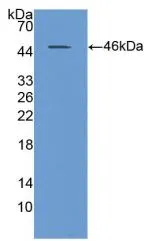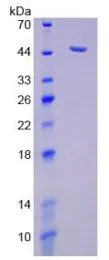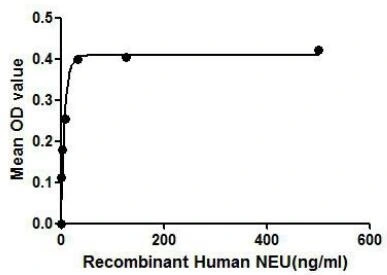
WB analysis of GTX00130-pro Human NEU1 protein.
Human NEU1 protein, His tag
GTX00130-PRO
Product group Molecular Biology
Overview
- SupplierGeneTex
- Product NameHuman NEU1 protein, His tag
- Delivery Days Customer9
- Application Supplier NoteNEU (Sialidase-1) is an enzyme that catalyzes the removal of sialic acid (N-acetylneuraminic acid) moities from glycoproteins and glycolipids. In the lysosome, this enzyme is part of a heterotrimeric complex together with beta-galactosidase and cathepsin A (CTSA). Thus a binding ELISA assay was conducted to detect the interaction of recombinant human NEU and recombinant human CTSA. Briefly, NEU were diluted serially in PBS, with 0.01% BSA (pH 7.4). Duplicate samples of 100 microl were then transferred to CTSA-coated microtiter wells and incubated for 2h at 37C. Wells were washed with PBST and incubated for 1h with anti-NEU pAb, then aspirated and washed 3 times. After incubation with HRP labelled secondary antibody, wells were aspirated and washed 3 times. With the addition of substrate solution, wells were incubated 15-25 minutes at 37C. Finally, add 50 microl stop solution to the wells and read at 450nm immediately. The binding activity of NEU and CTSA was in a dose dependent manner.
- ApplicationsFunctional Assay
- CertificationResearch Use Only
- ConjugateUnconjugated
- Scientific DescriptionThe protein encoded by this gene is a lysosomal enzyme that cleaves terminal sialic acid residues from substrates such as glycoproteins and glycolipids. In the lysosome, this enzyme is part of a heterotrimeric complex together with beta-galactosidase and cathepsin A (the latter is also referred to as protective protein). Mutations in this gene can lead to sialidosis, a lysosomal storage disease that can be type 1 (cherry red spot-myoclonus syndrome or normosomatic type), which is late-onset, or type 2 (the dysmorphic type), which occurs at an earlier age with increased severity. [provided by RefSeq, Jul 2008]
- Storage Instruction-20°C or -80°C,2°C to 8°C
- UNSPSC12352204


